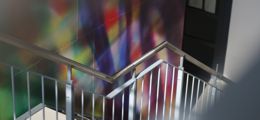| abstract | | Chinese hamster ovary (CHO) cells are the most dependable host cells for the industrial production of therapeutic proteins. At present, CHO cells are the most important “industrial mammalian cell line”, similarly to Escherichia coli or Saccharomyces cerevisiae cells, among various mammalian cell lines. Recently, we constructed CHO genomic bacterial artificial chromosome (BAC) library from a mouse dihydrofolate reductase (DHFR) gene-amplified CHO DR1000L-4N cell line for genome-wide analysis of CHO cell lines. The CHO BAC library consisted of 122,281 clones and was expected to cover the entire CHO genome five times. A detailed physical chromosomal map of the CHO DG44 cell line was constructed by fluorescence in situ hybridization (FISH) imaging using randomly selected 303 BAC clones as hybridization probes (BAC-FISH). The two longest chromosomes were completely paired chromosomes; other chromosomes were partly deleted or rearranged. The end sequences of 624 BAC clones, including 287 mapped BAC clones, were analyzed and 1,119 informative BAC end sequences were obtained. Among 303 mapped BAC clones, 185 clones were used for BAC-FISH analysis of CHO K1 chromosomes and 94 clones for primary Chinese hamster lung cells. Based on this constructed physical map and end sequences, the chromosome rearrangements between CHO DG44, CHO K1, and primary Chinese hamster cells were investigated. Among 20 CHO chromosomes, 8 were conserved without large rearrangement in CHO DG44, CHO K1, and primary Chinese hamster cells. We are now investigating the chromosomal changes during long-term cultivation. This result suggested that these chromosomes were stable and essential in CHO cells and supposedly conserved in other CHO cell lines. |



